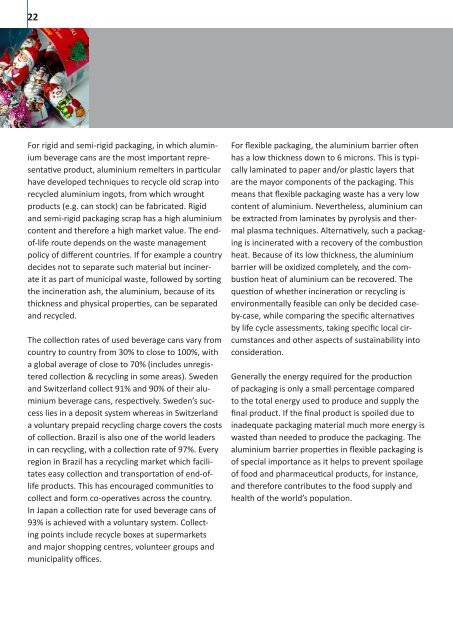Global Aluminium Recycling Brochure - Transport
Global Aluminium Recycling Brochure - Transport
Global Aluminium Recycling Brochure - Transport
You also want an ePaper? Increase the reach of your titles
YUMPU automatically turns print PDFs into web optimized ePapers that Google loves.
22<br />
For rigid and semi-rigid packaging, in which aluminium<br />
beverage cans are the most important representative<br />
product, aluminium remelters in particular<br />
have developed techniques to recycle old scrap into<br />
recycled aluminium ingots, from which wrought<br />
products (e.g. can stock) can be fabricated. Rigid<br />
and semi-rigid packaging scrap has a high aluminium<br />
content and therefore a high market value. The endof-life<br />
route depends on the waste management<br />
policy of different countries. If for example a country<br />
decides not to separate such material but incinerate<br />
it as part of municipal waste, followed by sorting<br />
the incineration ash, the aluminium, because of its<br />
thickness and physical properties, can be separated<br />
and recycled.<br />
The collection rates of used beverage cans vary from<br />
country to country from 30% to close to 100%, with<br />
a global average of close to 70% (includes unregistered<br />
collection & recycling in some areas). Sweden<br />
and Switzerland collect 91% and 90% of their aluminium<br />
beverage cans, respectively. Sweden’s success<br />
lies in a deposit system whereas in Switzerland<br />
a voluntary prepaid recycling charge covers the costs<br />
of collection. Brazil is also one of the world leaders<br />
in can recycling, with a collection rate of 97%. Every<br />
region in Brazil has a recycling market which facilitates<br />
easy collection and transportation of end-oflife<br />
products. This has encouraged communities to<br />
collect and form co-operatives across the country.<br />
In Japan a collection rate for used beverage cans of<br />
93% is achieved with a voluntary system. Collecting<br />
points include recycle boxes at supermarkets<br />
and major shopping centres, volunteer groups and<br />
municipality offices.<br />
For flexible packaging, the aluminium barrier often<br />
has a low thickness down to 6 microns. This is typically<br />
laminated to paper and/or plastic layers that<br />
are the mayor components of the packaging. This<br />
means that flexible packaging waste has a very low<br />
content of aluminium. Nevertheless, aluminium can<br />
be extracted from laminates by pyrolysis and thermal<br />
plasma techniques. Alternatively, such a packaging<br />
is incinerated with a recovery of the combustion<br />
heat. Because of its low thickness, the aluminium<br />
barrier will be oxidized completely, and the combustion<br />
heat of aluminium can be recovered. The<br />
question of whether incineration or recycling is<br />
environmentally feasible can only be decided caseby-case,<br />
while comparing the specific alternatives<br />
by life cycle assessments, taking specific local circumstances<br />
and other aspects of sustainability into<br />
consideration.<br />
Generally the energy required for the production<br />
of packaging is only a small percentage compared<br />
to the total energy used to produce and supply the<br />
final product. If the final product is spoiled due to<br />
inadequate packaging material much more energy is<br />
wasted than needed to produce the packaging. The<br />
aluminium barrier properties in flexible packaging is<br />
of special importance as it helps to prevent spoilage<br />
of food and pharmaceutical products, for instance,<br />
and therefore contributes to the food supply and<br />
health of the world’s population.


